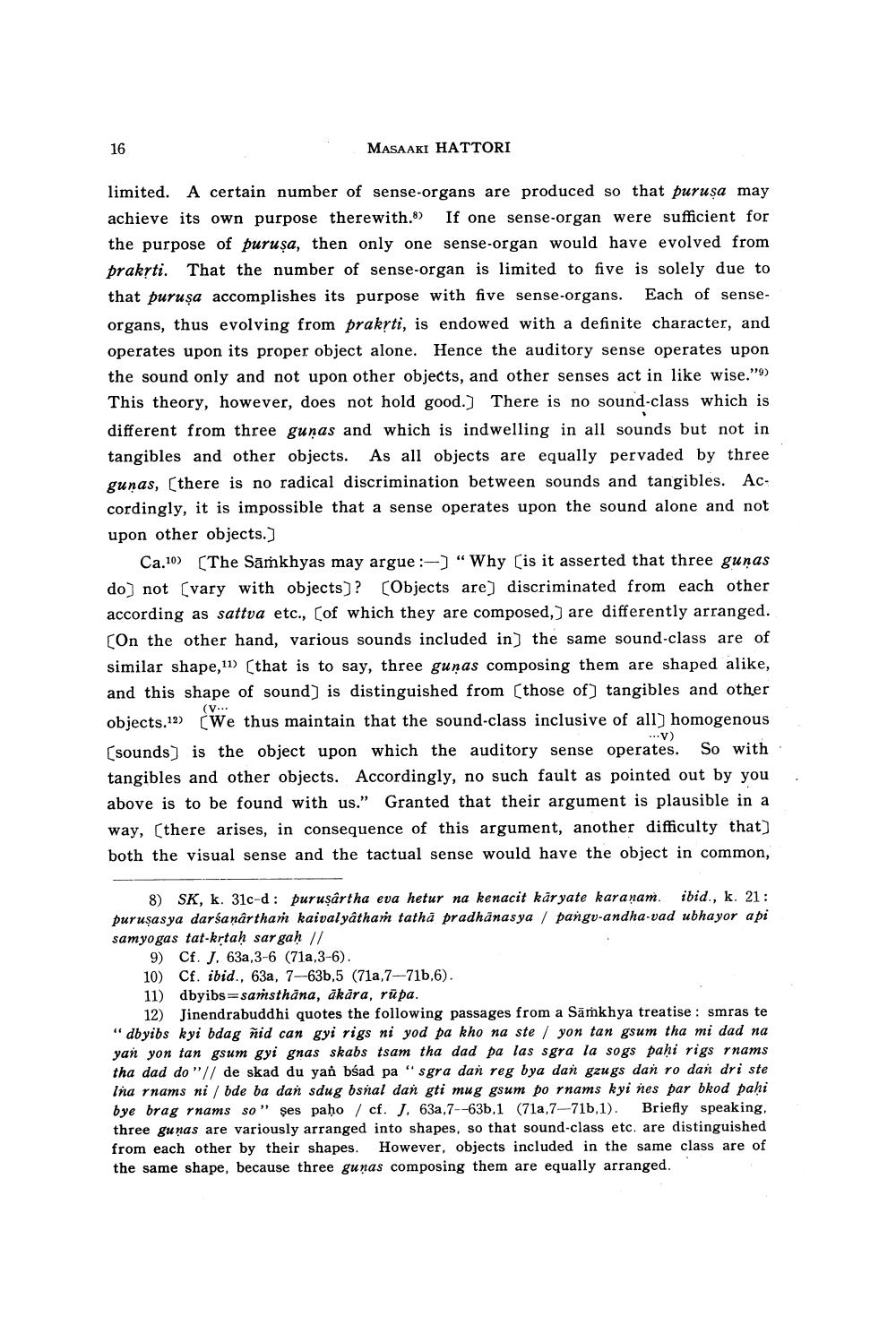________________
16
MASAAKI HATTORI
limited. A certain number of sense-organs are produced so that puruṣa may achieve its own purpose therewith.8) If one sense-organ were sufficient for the purpose of puruşa, then only one sense-organ would have evolved from prakṛti. That the number of sense-organ is limited to five is solely due to that puruşa accomplishes its purpose with five sense-organs. Each of senseorgans, thus evolving from prakṛti, is endowed with a definite character, and operates upon its proper object alone. Hence the auditory sense operates upon the sound only and not upon other objects, and other senses act in like wise.") This theory, however, does not hold good.] There is no sound-class which is different from three gunas and which is indwelling in all sounds but not in tangibles and other objects. As all objects are equally pervaded by three gunas, [there is no radical discrimination between sounds and tangibles. Accordingly, it is impossible that a sense operates upon the sound alone and not upon other objects.]
Ca.10) [The Samkhyas may argue :-) "Why [is it asserted that three gunas do] not [vary with objects]? [Objects are] discriminated from each other according as sattva etc., [of which they are composed,] are differently arranged. [On the other hand, various sounds included in] the same sound-class are of similar shape, [that is to say, three gunas composing them are shaped alike, and this shape of sound] is distinguished from [those of] tangibles and other objects.12 We thus maintain that the sound-class inclusive of all] homogenous [sounds] is the object upon which the auditory sense operates. So with tangibles and other objects. Accordingly, no such fault as pointed out by you above is to be found with us." Granted that their argument is plausible in a way, there arises, in consequence of this argument, another difficulty that] both the visual sense and the tactual sense would have the object in common,
(V...
...V)
8) SK, k. 31c-d: puruşârtha eva hetur na kenacit karyate karanam. ibid., k. 21: puruṣasya darśanârtham kaivalyatham tatha pradhanasya pangv-andha-vad ubhayor api samyogas tat-krtaḥ sargaḥ //
9) Cf. J. 63a,3-6 (71a,3-6).
10) Cf. ibid., 63a, 7-63b,5 (71a,7-71b,6).
11) dbyibs samsthāna, äkära, rupa.
12) Jinendrabuddhi quotes the following passages from a Samkhya treatise: smras te "dbyibs kyi bdag ñid can gyi rigs ni yod pa kho na ste/ yon tan gsum tha mi dad na yan yon tan gsum gyi gnas skabs tsam tha dad pa las sgra la sogs paḥi rigs rnams tha dad do"// de skad du yan bśad pa "sgra dan reg bya dan gzugs dan ro dan dri ste Ina rnams ni / bde ba dan sdug bsnal dan gti mug gsum po rnams kyi nes par bkod paḥi bye brag rnams so" şes paho cf. J. 63a,7--63b.1 (71a,7-71b,1). Briefly speaking, three gunas are variously arranged into shapes, so that sound-class etc. are distinguished from each other by their shapes. However, objects included in the same class are of the same shape, because three gunas composing them are equally arranged.




